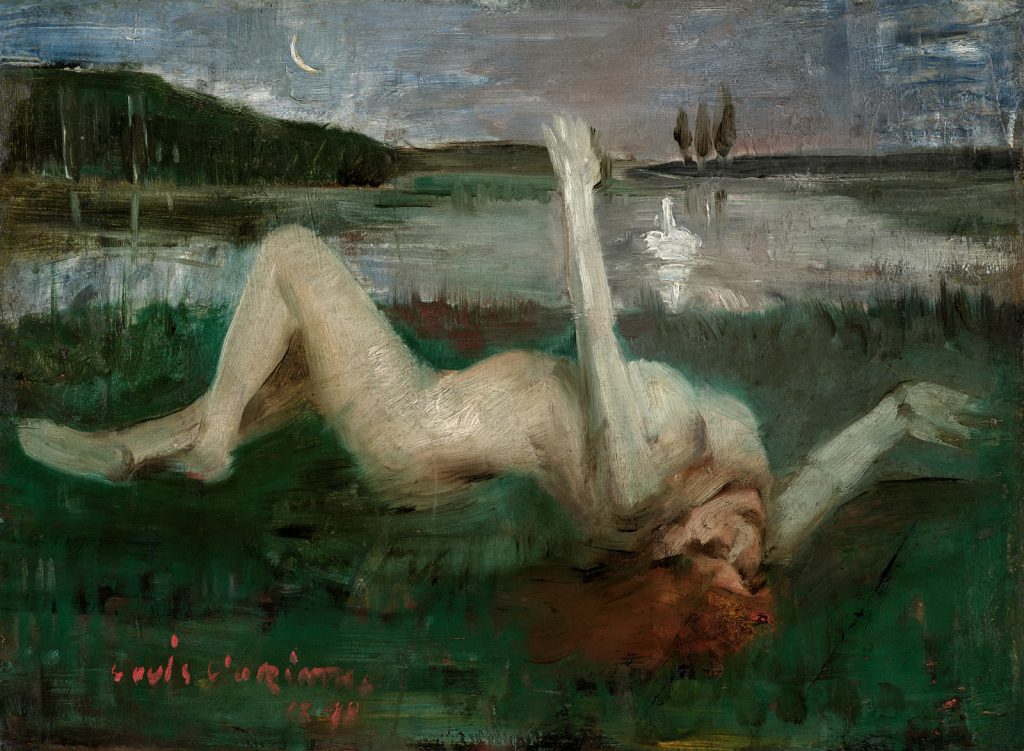Lovis Corinth
(Tapiau 1858 - 1925 Zandvoort)
Leda, 1890
Oil on cardboard, laid down on panel, 36 x 49.5 cm
Signed and dated lower left Lovis Corinth / 1890
Provenance:
Ernst Zaeslein (1863-1918), Berlin;
Galerie Eduard Schulte, the Ernst Zaeslein collection, 1912, no. 568;
Alfred Walter von Heymel, Berlin (1878-1914), writer and publisher;
Frankfurt, Prestel, auction sale, May 10, 1915, lot 40;
Berlin, Cassirer-Helbing, property from the estate of A. W. von Heymel, March 8, 1917, lot 12;
Theodor Schall, Berlin (acquired in 1917);
Berlin, Cassirer-Helbing, the Theodor Schall collection, October 26, 1926, lot 4;
E. Weißner, Berlin;
Berlin, Leo Spik, auction sale 536, April 10-12, 1986, lot 60, plate VII;
Bremen, Bolland & Marotz, auction sale October 17, 1986, lot 762, repr.;
Private collection, USA.
Literature:
Charlotte Berend-Corinth, Die Gemälde von Lovis Corinth, Munich 1958, no. 73;
Charlotte Berend-Corinth, Lovis Corinth: Die Gemälde, catalogue raisonné, Munich 1992, p. 65, no. 73, repr. p. 330;
Christine Biró, Zwischen Fiktion und Wirklichkeit. Zur Bedeutung weiblicher Identität on den Bildern Lovis Corinths, Herbolzheim 2000, p. 33.
Lovis Corinth’s training under William Bouguereau and Tony Robert-Fleury at the Académie Julian in Paris in the years 1884-7 was to lay the foundations for his intense preoccupation with the subject of the female nude. These Paris years proved a highly formative period in a career in which the nude figure came to acquire a central position in his oeuvre. During his stay in Paris he produced some twelve paintings depicting the nude. Shaped by academic tradition and influenced by the work of Bouguereau, Corinth frequently drew on mythological sources for his interpretations of the three great themes of love, sexuality and death. But in the realization of his paintings he resolutely pursued a stylistic direction of his own.1
The story of the seduction of Leda, the daughter of the Aetolian king Thestios, has attracted artists for centuries with its potential for multi-layered symbolism. In the ancient Greek myth Leda was seduced by Jupiter who appeared to her in the guise of a swan. In a later version of the myth, twins — Helen of Troy and Polydeuces — were born as a result of the union while Leda was carrying the mortal twins Castor and Clytemnestra fathered by her husband Tyndareus, king of Sparta.
Corinth took up the subject of Leda four times over a period of nearly thirty years (Berend-Corinth nos. 73, 229, 476 and 753), so that as a series the paintings can be seen as mirroring his stylistic development. The present painting, dated 1890, is the first in the series. The work’s dynamic, expressive brushwork suggests that it was executed spontaneously, probably in his Königsberg studio.2 The figure of a red-haired femme fatale is shown in a trance-like state of erotically charged excitement while the tiny form of a swan can be distinguished swimming on the water behind her. Each of the four works represents a different visualization of the supposed sensual seductress in women — the three later works all being direct portrayals of the sexual act.
The naked figure of Leda dominates the foreground of the painting. Her head is positioned almost touching the lower edge of the image and her body is thrust up against it leaving little physical distance between figure and viewer. Jupiter, disguised as a swan, glides silently away from the scene of his seduction towards the setting sun, abandoning an elated Leda. Her posture represents Corinth’s view of women’s supposed animalistic nature.
A significant portion of Corinth’s 1908 textbook on painting, titled Das Erlernen der Malerei, focuses on the handling of the nude figure. As a painter, he considered precise study of the naked body and accuracy in the depiction of it to be fundamental to artistic production.3
1 See Barbara Martin, Nackt und bloß: Lovis Corinth und der Akt um 1900, exhib. cat., Hanover, Niedersächsisches Landesmuseum, February 26-June 11, 2017, pp. 12-13.
2 After a brief stay in Königsberg, he returned to Munich in 1891, where he joined the Secessionist painters grouped around Franz von Stuck, Fritz von Uhde and Wilhelm Trübner.
3 See Nackt und bloß, op. cit., pp. 69-70.

